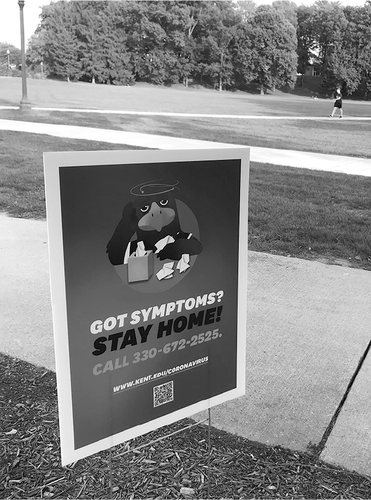Between a Rock and a Hard Past
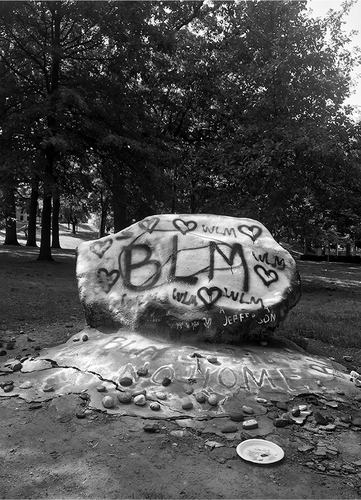
Nonetheless, it is easy to doubt that this is the case when you look at the current state of the nation. This is exemplified by the many comments on Fox News posts that prompt conservatives to group together and start shooting “Libs” and protestors en masse. As someone who has been a Kent State student since 2010, it is devastating to think how so many people are comfortable with idea of shooting protestors 50 years after May 4th, 1970. Dare I even mention Kyle Rit-tenhouse, charged with fatally shooting two people in attendance of the Black Lives Matter (BLM) protests in Kenosha, Wisconsin.
Even closer to home than conservative comment sections on the Internet, Kent State had an incident this semester when someone painted racist messages on the campus rock. The campus rock is a large boulder on Kent campus with many overlapping layers of messages painted by students that include anything ranging from sorority letters, words of protest, or wedding engagements. This rock is generally regarded as a positive symbol of our university’s culture but, unfortunately, has also been used as a weapon for racial violence on numerous occasions. “White lives matter” was twice painted over other markings— “say their names” on one occurrence and an image of an African queen on another. To cover up these white supremacist messages, “hate has no home here” was painted on the rock, but yet again, this affirmative message was obliterated and replaced with the racist message “Blacks have no home here.”
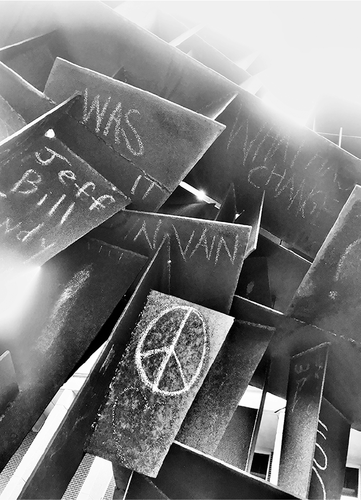
As one would expect, this back-and-forth between hate and love prompted a series of protests at our university. About 600 protesters walked from the building that houses the Pan-African studies program to the campus rock in opposition to the university’s lackluster initial response to the hate crime. At this demonstration, The Black United Students (BUS) also delivered a list of demands for the president of the university that protect Black students (e.g., providing more security escorts and incorporating an anti-hate clause into the student code of conduct).
The battle over Kent State’s campus rock, the recent shootings of protestors, and law enforcement’s continued use of excessive force further reiterate the relevance of the inquiry proposed on the Don Drumm sculpture in our country today. To help shed light on what has changed, I interviewed Dr. Jerry Lewis— an emeritus professor in the sociology department at Kent State who was present for the May 4th shootings. Dr. Lewis’s legacy at Kent State includes his service as a volunteer faculty marshal responsible for being a calming presence at the student protests during the Vietnam era, because he cared about keeping the students safe. His prior military experience helped him recognize when the National Guard started shooting real bullets, allowing him to protect students by shouting for them to get down on the ground. As someone who witnessed the tragedy firsthand, he describes the four young people who lost their lives that day as heroes but grieves over the fact that we may never know what they could have contributed to our society— as a potential teacher, military officer, artist, etc. Although they were not his own students, he sympathetically notes how losing a student can feel the same as losing a child when you are a teacher.

Was it in vain? What has changed
Dr. Lewis believes that a lot has changed at Kent State since that devastating day 50 years ago. He notes that one of the sharpest distinctions is between the Vietnam era and today’s era. Not unlike today, there was a protest culture (i.e., organized social interaction, discourse, and motives of protestors made visible through symbolic expression) that was rather prominent at that time. However, the protest culture was more so surrounding the salience of the draft rather than BLM. Dr. Lewis felt that culture at that time was observable through cultural vehicles like Woodstock, the actress Jane Fonda, the ubiquitous 1960’s peace sign, the music of the Beatles and Bob Dylan, and so on. He also describes how today’s protests can be a lot lengthier than those at that time, noting that the 100-day long protest in Portland is almost unheard of in comparison to the 1970’s protest era. Furthermore, he believes that another major difference between now and then is how the president perceives the protests, stating “Nixon understood why the students were protesting whereas Trump doesn’t seem to understand why the BLM or Me Too protestors are protesting.” Despite Nixon’s understanding, another major change since then noted by Dr. Lewis is that the importance of May 4th was not nearly as recognized by Kent State or the world during that period. It took a significant amount of time for what happened to be adequately acknowledged, even by our university’s former presidents. By contrast, today, the media expects that Kent State provides some sort of recognition of the events of May 4th, 1970 every year on that date. Lastly, Dr. Lewis does not really remember the campus rock as a major medium for advertising protests, or even a political object at all at the time of the May 4th protests. Instead, it was simply used as a symbol of everyday campus life, such as through fraternity or sorority advertising—it was the Commons (i.e., an open field for student leisure and activities) that was the meeting grounds for political action.
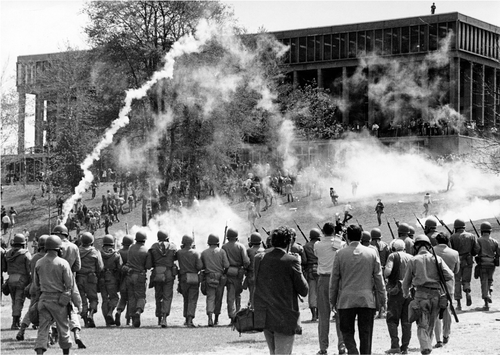
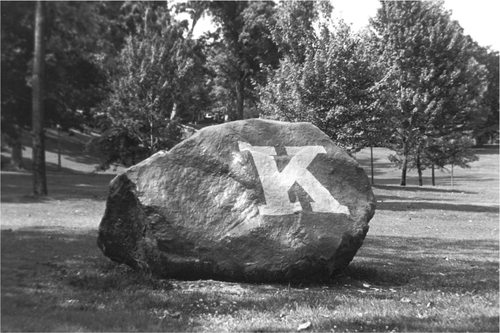
In juxtaposition to Dr. Lewis’s thoughts and experiences stand the perspectives of a student protester who attended the Black Lives Matter protests on campus who I also interviewed. His responses provide additional insights into how our university’s culture compares and contrasts with the Vietnam Era. This student wanted to attend the BLM protests because, although he believes voting is essential, he also believes it is not enough. As a person of color, he cares about the well-being of himself, his family and countless others, and he sought to take action in support of BLM for this reason. He also wanted to do something about the feelings of sadness, anger, and hopelessness he felt about sharing a campus with other young people willing to threaten an entire group of people by writing racist messages on the campus rock. This instance of racial violence was particularly heart-breaking for this student because he looks up to his younger peers as role models on how to protest. Unlike the 1960’s, he feels there is not a clear leader for him to look up to that is still alive today, such as some of Dr. Lewis’s favorite protesters—Martin Luther King Jr. and Mahatma Gandhi.
Reflecting on marching past the May 4th memorial on the way to protest around the rock, he shared his thoughts on the police shootings he was protesting:
It just made me wish that more white people could recognize that this isn’t only just a Black vs. white issue; this is an innocent-human-beings vs. corrupt-people-in-power issue. Instead of dismissing BLM because white people are also killed by police, people need to understand that an unjust killing is an unjust killing—an unjust system is an unjust system and they should be just as mad about the state of our justice system as we are.
Although this student acknowledges that BLM and the events of May 4th both compare in the sense that they both involve an unjust killing from law enforcement, this student also brings up one major, obvious difference between now and then: Coronavirus. Whereas the salience of the Vietnam draft permeated much of protest life 50 years ago, we have all been involuntarily drafted into the war against COVID-19. The pandemic has had a major impact on campus protest culture, prompting protesters to wear masks and keep social distance. The National Guard is also on our campus again this semester (yes, you heard that right), but serving a much different purpose. This time they do not have guns—they have stethoscopes. A team of medics from the Ohio National Guard is offering free Coronavirus testing to help mitigate its spread on campus. There have clearly been a lot of changes that have occurred over the last 50 years. However, the desire among protesters to protect the innocent lives of young people still remains constant—whether it be from an unjust draft, the National Guard, systemic racism, or coronavirus.
